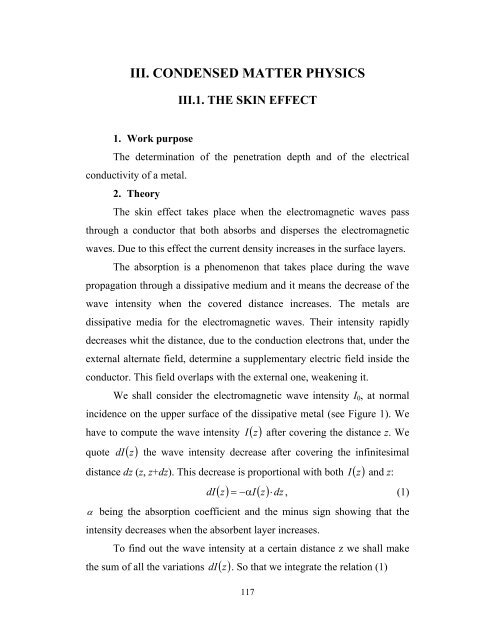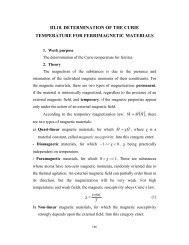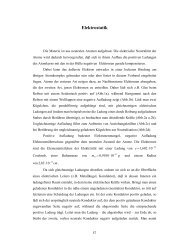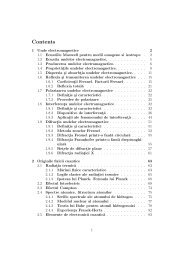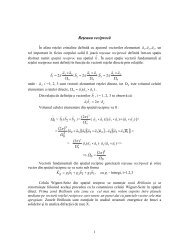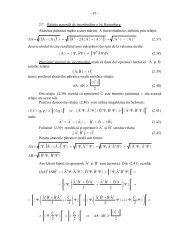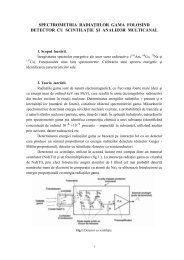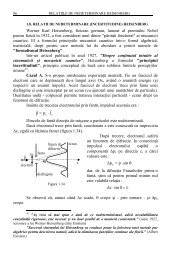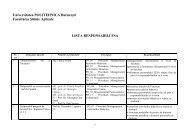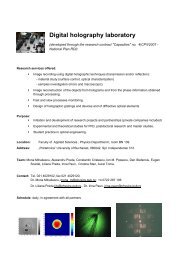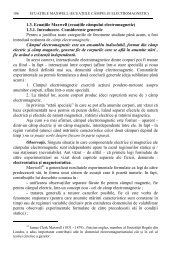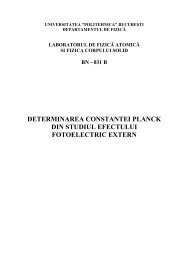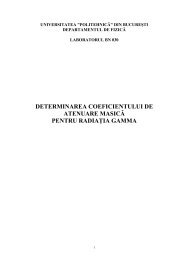iii. condensed matter physics iii.1. the skin effect
iii. condensed matter physics iii.1. the skin effect
iii. condensed matter physics iii.1. the skin effect
Create successful ePaper yourself
Turn your PDF publications into a flip-book with our unique Google optimized e-Paper software.
III. CONDENSED MATTER PHYSICS<br />
1. Work purpose<br />
III.1. THE SKIN EFFECT<br />
The determination of <strong>the</strong> penetration depth and of <strong>the</strong> electrical<br />
conductivity of a metal.<br />
2. Theory<br />
The <strong>skin</strong> <strong>effect</strong> takes place when <strong>the</strong> electromagnetic waves pass<br />
through a conductor that both absorbs and disperses <strong>the</strong> electromagnetic<br />
waves. Due to this <strong>effect</strong> <strong>the</strong> current density increases in <strong>the</strong> surface layers.<br />
The absorption is a phenomenon that takes place during <strong>the</strong> wave<br />
propagation through a dissipative medium and it means <strong>the</strong> decrease of <strong>the</strong><br />
wave intensity when <strong>the</strong> covered distance increases. The metals are<br />
dissipative media for <strong>the</strong> electromagnetic waves. Their intensity rapidly<br />
decreases whit <strong>the</strong> distance, due to <strong>the</strong> conduction electrons that, under <strong>the</strong><br />
external alternate field, determine a supplementary electric field inside <strong>the</strong><br />
conductor. This field overlaps with <strong>the</strong> external one, weakening it.<br />
We shall consider <strong>the</strong> electromagnetic wave intensity I0, at normal<br />
incidence on <strong>the</strong> upper surface of <strong>the</strong> dissipative metal (see Figure 1). We<br />
have to compute <strong>the</strong> wave intensity I ( z)<br />
after covering <strong>the</strong> distance z. We<br />
quote dI ( z)<br />
<strong>the</strong> wave intensity decrease after covering <strong>the</strong> infinitesimal<br />
distance dz (z, z+dz). This decrease is proportional with both I ( z)<br />
and z:<br />
( z)<br />
−αI<br />
( z)<br />
dz<br />
dI = ⋅ , (1)<br />
α being <strong>the</strong> absorption coefficient and <strong>the</strong> minus sign showing that <strong>the</strong><br />
intensity decreases when <strong>the</strong> absorbent layer increases.<br />
To find out <strong>the</strong> wave intensity at a certain distance z we shall make<br />
<strong>the</strong> sum of all <strong>the</strong> variations dI ( z)<br />
. So that we integrate <strong>the</strong> relation (1)<br />
117
and we obtain:<br />
I<br />
( z)<br />
dI<br />
∫ I<br />
I<br />
0<br />
( z)<br />
( z)<br />
z<br />
= −α<br />
118<br />
∫<br />
0<br />
dz<br />
( z)<br />
= I exp(<br />
− z)<br />
(2)<br />
I 0 α . (3)<br />
Figure 1.<br />
The relation (3) shows that in a conductor <strong>the</strong> intensity of <strong>the</strong><br />
electromagnetic waves exponentially drops with <strong>the</strong> distance. As<br />
<strong>the</strong> amplitude E ( z)<br />
also drops exponentially with <strong>the</strong> distance:<br />
where 0<br />
2<br />
I ∝ E ,<br />
⎛ αz<br />
⎞ ⎛ z ⎞<br />
E ( z)<br />
= E0<br />
exp⎜− ⎟ = E0<br />
exp⎜−<br />
⎟ ,<br />
⎝ 2 ⎠ ⎝ 2δ<br />
⎠<br />
(4)<br />
E is <strong>the</strong> electric field amplitude of <strong>the</strong> incident wave and α = δ 1 ,<br />
called penetration depth or <strong>skin</strong> thickness,, represents <strong>the</strong> distance over<br />
which <strong>the</strong> wave intensity decreases e times. This depth depends on <strong>the</strong><br />
wave frequency ν and on <strong>the</strong> medium electric and magnetic properties.<br />
Let us consider an infinite conductor half-space. We choose a<br />
Cartesian system of coordinate axes, such that <strong>the</strong> Ox and Oy axes belong<br />
to <strong>the</strong> separation plane (z = 0), and <strong>the</strong> Oz axis is oriented towards <strong>the</strong><br />
interior of <strong>the</strong> conductor (see Figure 2). The electric field intensity vector<br />
E r and <strong>the</strong> conduction current density vector j are oriented parallel to <strong>the</strong>
Ox axis, and <strong>the</strong> magnetic field induction vector B r is oriented parallel to<br />
r<br />
E = E , 0,<br />
0<br />
r<br />
j = j , 0,<br />
0<br />
r<br />
= 0 , B,<br />
0 . The<br />
<strong>the</strong> Oy axis. Hence ( ) , ( )<br />
x<br />
119<br />
x<br />
B y<br />
and ( )<br />
vector components are functions of <strong>the</strong> coordinate z and of <strong>the</strong> time t (<strong>the</strong>se<br />
components do not vary with <strong>the</strong> x and y coordinates). The equations that<br />
govern <strong>the</strong> <strong>skin</strong> <strong>effect</strong> analysis are <strong>the</strong> equations of <strong>the</strong> electromagnetic<br />
wave propagation in substances.<br />
Figure 2.<br />
Electromagnetic wave propagation through a conductor is studied by<br />
taking into account that <strong>the</strong> conduction current density is much greater than<br />
<strong>the</strong> displacement current density. Neglecting <strong>the</strong> displacement current, we<br />
obtain <strong>the</strong> following equations for <strong>the</strong> electric and magnetic field<br />
propagation through <strong>the</strong> conductors:<br />
r<br />
r ∂E<br />
∆E<br />
= σµ<br />
,<br />
∂t<br />
r<br />
r ∂B<br />
∆B<br />
= σµ<br />
∂t<br />
(5)<br />
In our case, we have:<br />
2<br />
E x<br />
2<br />
x<br />
2<br />
y<br />
∂<br />
∂z<br />
∂E<br />
= σµ<br />
∂t<br />
∂ B y ∂B<br />
, = σµ<br />
. (6)<br />
2<br />
∂z<br />
∂t<br />
We remark that we may write <strong>the</strong> y component of <strong>the</strong> magnetic field B r as a<br />
function of <strong>the</strong> x component of <strong>the</strong> electric field E r , if we use <strong>the</strong> Maxwell-<br />
Faraday equation, which can be rewritten as follows:
( ∧ E)<br />
∇ r<br />
y<br />
∂E<br />
=<br />
∂z<br />
x<br />
∂B<br />
= −<br />
∂t<br />
120<br />
y<br />
. (7)<br />
We accept a periodical time variation of <strong>the</strong> electric field, current density<br />
and magnetic field such that:<br />
( z,<br />
t)<br />
E(<br />
z)<br />
exp(<br />
iωt<br />
) , j ( z,<br />
t)<br />
= j(<br />
z)<br />
exp(<br />
iωt<br />
) , B ( z,<br />
t)<br />
= B(<br />
z)<br />
exp(<br />
iωt<br />
).<br />
E x<br />
x<br />
y<br />
= (8)<br />
Replacing <strong>the</strong> expression of E x from Eq. (8) in Eq. (6), we obtain:<br />
d<br />
2<br />
E<br />
dz<br />
( z)<br />
2<br />
= iωσµ<br />
E<br />
( z)<br />
. (9)<br />
Quoting p = iωσµ<br />
2<br />
, <strong>the</strong> differential equation (9) will become:<br />
2<br />
( z)<br />
d E<br />
2<br />
dz<br />
2<br />
= p E(<br />
z)<br />
. (10)<br />
The general solution of this differential equation is:<br />
where A 1 and 2<br />
( z)<br />
= A ( pz)<br />
+ A exp(<br />
pz)<br />
E 1 exp 2 − , (11)<br />
A are two integration constants and<br />
ωσµ<br />
p = iωσµ<br />
= i ωσµ = ( 1+<br />
i)<br />
, (12)<br />
2<br />
where we have used i ( 1+ i)<br />
2<br />
determined from <strong>the</strong> following conditions:<br />
- for → +∞,<br />
E(<br />
z)<br />
→ 0<br />
z hence A 0 ;<br />
= . The integration constants are<br />
1 =<br />
z → 0, E z = E 0 ≡ E = A .<br />
- for ( ) ( ) 0 2<br />
So, <strong>the</strong> solution (11) will become:<br />
⎡<br />
E(<br />
z)<br />
= E0<br />
exp( pz)<br />
= E0<br />
exp⎢−<br />
( 1+<br />
i)<br />
⎣<br />
If we introduce <strong>the</strong> constant:<br />
ωσµ ⎤<br />
⋅ z⎥<br />
.<br />
2 ⎦<br />
(13)<br />
δ =<br />
1<br />
,<br />
2ωσµ<br />
(14)
<strong>the</strong> equation (13) may be written as:<br />
⎡ z ⎤ ⎛ z ⎞ ⎛ z ⎞<br />
E . (15)<br />
( z)<br />
= E0<br />
exp<br />
⎢<br />
− ( 1+<br />
i)<br />
⎥<br />
= E0<br />
exp⎜−<br />
⎟⋅<br />
exp⎜−<br />
i ⎟<br />
⎣ 2δ⎦<br />
⎝ 2δ<br />
⎠ ⎝ 2δ<br />
⎠<br />
Taking into account <strong>the</strong> equation (8) and (15) we obtain <strong>the</strong>n:<br />
⎛ z ⎞ ⎡ ⎛ z ⎞⎤<br />
E x . (16)<br />
( z,<br />
t)<br />
= E0<br />
exp⎜−<br />
⎟exp⎢i⎜<br />
ωt<br />
− ⎟⎥<br />
⎝ 2δ<br />
⎠ ⎣ ⎝ 2δ<br />
⎠⎦<br />
To compute <strong>the</strong> current density j x and <strong>the</strong> magnetic field B y , we use<br />
similar relations:<br />
⎛ z ⎞ ⎡ ⎛ z ⎞⎤<br />
j x ( z,<br />
t)<br />
= σE0<br />
exp⎜−<br />
⎟exp⎢i⎜<br />
ωt<br />
− ⎟⎥<br />
, (17)<br />
⎝ 2δ<br />
⎠ ⎣ ⎝ 2δ<br />
⎠⎦<br />
2δσµ<br />
⎛ z ⎞ ⎡ ⎛ z ⎞⎤<br />
B y . (18)<br />
In <strong>the</strong>se relations,<br />
( z,<br />
t)<br />
= E0<br />
exp⎜−<br />
⎟exp⎢i⎜<br />
ωt<br />
− ⎟<br />
1+<br />
i<br />
⎥<br />
⎝ 2δ<br />
⎠ ⎣ ⎝ 2δ<br />
⎠⎦<br />
δ =<br />
1<br />
2ωσµ<br />
121<br />
=<br />
1<br />
4πυσµ<br />
(19)<br />
represents <strong>the</strong> penetration depth of <strong>the</strong> electromagnetic wave through <strong>the</strong><br />
conductor. Its value varies inversely proportional with <strong>the</strong> square root of<br />
both <strong>the</strong> frequency of <strong>the</strong> field ν and <strong>the</strong> metal conductivity σ. Due to this<br />
relation, we may notice that, simultaneously with <strong>the</strong> absorption, <strong>the</strong>re is a<br />
dispersion of <strong>the</strong> electromagnetic waves. If we increase <strong>the</strong> frequency ν, <strong>the</strong><br />
penetration depth decreases, meaning that <strong>the</strong> electromagnetic wave is<br />
localized at <strong>the</strong> conductor surface. Due to this <strong>effect</strong>, <strong>the</strong> conductors used<br />
for high frequency currents may look like pipes, to save up material.<br />
In Table 1 we find <strong>the</strong> values of <strong>the</strong> penetration depth δ for an<br />
alternate current through a copper conductor, for two frequencies of <strong>the</strong><br />
alternate current: 50 Hz and<br />
decreases with <strong>the</strong> increase of <strong>the</strong> current frequency.<br />
5<br />
5 ⋅ 10 Hz. Hence <strong>the</strong> <strong>skin</strong> thickness δ
Table 1<br />
Material σ (Ω -1 ·m -1 ) ν (Hz) δ (mm)<br />
Copper 5.8 . 10 7 50 4.67<br />
Copper 5.8 . 10 7 5 . 10 5 0.0467<br />
In this paper we will determine <strong>the</strong> penetration depth δ and <strong>the</strong><br />
electrical conductivity σ for various frequency values. An electromagnetic<br />
wave of a known frequency will fall on a conductor made from one or<br />
more metallic plates and we will record <strong>the</strong> amplitude of <strong>the</strong> alternate<br />
voltage determined in a receiving coil by <strong>the</strong> waves that pass through <strong>the</strong><br />
plates. Due to <strong>the</strong> proportionality between <strong>the</strong> voltage and <strong>the</strong> electric field<br />
intensity, <strong>the</strong> amplitude of <strong>the</strong> incident alternate voltage U 0 drops<br />
exponentially with <strong>the</strong> distance z and it is described by Eq. (4), meaning:<br />
so that<br />
or<br />
⎛ z ⎞<br />
U , (20)<br />
( z)<br />
= U 0 exp⎜−<br />
⎟<br />
⎝ 2δ<br />
⎠<br />
z<br />
U = logU<br />
− , (21)<br />
2δ<br />
log 0<br />
U<br />
log<br />
U<br />
0<br />
122<br />
z<br />
= . (22)<br />
2δ<br />
If we draw <strong>the</strong> dependence of log U 0 U upon z, we will obtain a<br />
straight line with <strong>the</strong> slope m = 1 2δ<br />
. By determining <strong>the</strong> slope we will find<br />
<strong>the</strong> penetration depth δ = 1 2m.<br />
From <strong>the</strong> relation (14), we notice that δ is a linear function of 1 ν<br />
δ =<br />
1<br />
⋅<br />
4πσµ<br />
1 1<br />
= m ′ . (23)<br />
ν ν
Drawing <strong>the</strong> dependence of δ upon 1 ν , and determining <strong>the</strong> slope<br />
m’ of <strong>the</strong> straight line, we will compute <strong>the</strong> electrical conductivity:<br />
where<br />
µ ≈ µ<br />
0<br />
−7<br />
= 4π ⋅10<br />
N ⋅ A<br />
3. Experimental set-up<br />
-2<br />
1<br />
σ = , (24)<br />
2<br />
4πµ<br />
m′<br />
.<br />
The experimental set-up (see Figure 3) is made of a sine oscillation<br />
generator in <strong>the</strong> frequency range 10 – 100 kHz with a voltage level of 1000<br />
mV (Versatester – type E0502), on which we connect an oscillator coil B1<br />
and a receiving coil B2. Between <strong>the</strong>m we put some metallic sheets (of Cu,<br />
Al, Sn). By supplying an alternate current (through <strong>the</strong> coaxial cable C1) to<br />
<strong>the</strong> B1 coil, a phenomenon of electromagnetic induction appears, inducing<br />
an alternate voltage in <strong>the</strong> receiving coil B2. The induction current<br />
frequency may be varied, and <strong>the</strong> induced voltage in B2 is measured with<br />
<strong>the</strong> apparatus millivoltmeter (mV).<br />
4. Working procedure<br />
Figure 3.<br />
1. The device is plugged in at 220 V a. c. and <strong>the</strong> coaxial cable C1 of <strong>the</strong><br />
oscillator coil B1 is connected at <strong>the</strong> muff “IESIRE 50”. We press <strong>the</strong> key<br />
123
“10 – 100 kHz”, and <strong>the</strong> level selector (NIVEL INTERN) is on “1000<br />
mV”.<br />
2. With <strong>the</strong> fine frequency selector “FRECVENTA” we choose a frequency<br />
(for instance 50 kHz), which is read on <strong>the</strong> digital display, by choosing<br />
“INTERN F” from <strong>the</strong> internal switch.<br />
3. We determine on <strong>the</strong> voltmeter <strong>the</strong> voltage U0 for zero absorber<br />
thickness, switching <strong>the</strong> external switch on “EXTERN F”.<br />
4. We choose a metallic sheet of a known thickness z (zAl = 80 µm, zCu = 40<br />
µm, zSn = 50 µm), which is placed between <strong>the</strong> coils B1 and B2, and we<br />
determine <strong>the</strong> received voltage on <strong>the</strong> millivoltmeter, switching <strong>the</strong> external<br />
switch on “EXTERN F”. We successively add sheets of <strong>the</strong> same metal and<br />
we record for every total thickness z’ = n·z (n being <strong>the</strong> total number of<br />
sheets), <strong>the</strong> received voltage. At least ano<strong>the</strong>r 4 values of <strong>the</strong> frequency (for<br />
instance ν = 60, 70, 80, and 90 kHz) must be used for all thicknesses. The<br />
obtained data will be filled in Table 2:<br />
Table 2<br />
Metal ν (kHz) z (mm) U (mV) U0/U log U0/U δ (mm)<br />
... ... ... ... ... ... ...<br />
5. We shall repeat <strong>the</strong> experiment for <strong>the</strong> o<strong>the</strong>r metals too. For each metal,<br />
we will fill <strong>the</strong> obtained data in Table 2.<br />
6. In order to find <strong>the</strong> electrical conductivity σ of <strong>the</strong> used materials, after<br />
data processing, Table 3 is filled in:<br />
Table 3<br />
Metal ν (kHz) ν 1/2 (kHz 1/2 ) δ (mm)<br />
... ... ... ...<br />
5. Experimental data processing.<br />
1. For each metal and fixed frequency ν1, ν2, ..., we draw on <strong>the</strong> same<br />
log U U = f z , where U0 is <strong>the</strong> voltage when<br />
diagram <strong>the</strong> dependency ( )<br />
0<br />
124
all metallic sheets are removed. Using <strong>the</strong> relation (22) we obtain, for each<br />
metal, a family of straight lines for which we will determine <strong>the</strong>ir slopes<br />
m1, m2, ... We compute <strong>the</strong> penetration depths δ1, δ2, ..., knowing that<br />
δ = 1 2m<br />
.<br />
2. Using <strong>the</strong> data from Table 3, ano<strong>the</strong>r graph is drawn, with <strong>the</strong><br />
dependency of δ upon 1 ν . A straight line of slope m’ is obtained for<br />
each metal and using <strong>the</strong> relation (24) <strong>the</strong> electrical conductivities σ are<br />
determined.<br />
3. In order to determine <strong>the</strong> slope of <strong>the</strong> line y = ax , we can apply <strong>the</strong> least<br />
square method. Then, <strong>the</strong> estimated value for <strong>the</strong> slope is:<br />
n ⎛ n ⎞⎛<br />
n ⎞<br />
n∑<br />
x ⎜ ⎟⎜<br />
⎟<br />
i yi<br />
−<br />
⎜∑<br />
xi<br />
⎟⎜∑<br />
yi<br />
⎟<br />
i=<br />
1 ⎝ i=<br />
1 ⎠⎝<br />
i=<br />
1 ⎠<br />
a =<br />
, (25)<br />
n<br />
2<br />
2 ⎛ n ⎞<br />
n∑<br />
x − ⎜ ⎟<br />
i ⎜∑<br />
xi<br />
⎟<br />
i=<br />
1 ⎝ i=<br />
1 ⎠<br />
where n is <strong>the</strong> number of pairs {xi, yi} experimentally measured. The value<br />
of <strong>the</strong> parameter a is affected by <strong>the</strong> mean square deviation:<br />
⎧<br />
⎫<br />
⎪ n<br />
2 ⎪<br />
⎪ ∑ ( yi<br />
− axi<br />
) ⎪<br />
⎪ i=<br />
1<br />
⎪<br />
s a = ⎨<br />
⎬<br />
2<br />
⎪ ⎡ n<br />
⎤ ⎪<br />
2 ⎛ n ⎞<br />
⎪(<br />
n −1)<br />
⎢n∑<br />
x − ⎜ ⎟ ⎥<br />
i<br />
⎪<br />
⎪ ⎢ ⎜∑<br />
xi<br />
⎟<br />
1 1 ⎥ ⎪<br />
⎩ ⎣ i=<br />
⎝ i=<br />
⎠ ⎦ ⎭<br />
. (26)<br />
4. The linear dependence between log U 0 U and z is given by <strong>the</strong> relation<br />
logU 0 U = z 2δ<br />
. We quote y = logU<br />
0 U , x = z , a = 1 2δ.<br />
The<br />
unknown a must be expressed as a function of its estimated value and mean<br />
square deviation<br />
a = a ± sa<br />
. (27)<br />
Similarly<br />
δ = δ ± s δ .<br />
δ = δ a , we have:<br />
(28)<br />
Taking into account <strong>the</strong> relation ( )<br />
2 ⎛ dδ<br />
⎞ 2<br />
s = ⎜ ⎟ s<br />
δ<br />
a .<br />
⎝ da ⎠a=<br />
a<br />
(29)<br />
5. We apply <strong>the</strong> same method for <strong>the</strong> determination of <strong>the</strong> conductivity σ.<br />
In this case y = δ , x = 1 ν and<br />
σ = σ ± s . (30)<br />
125<br />
2<br />
σ<br />
1 2


